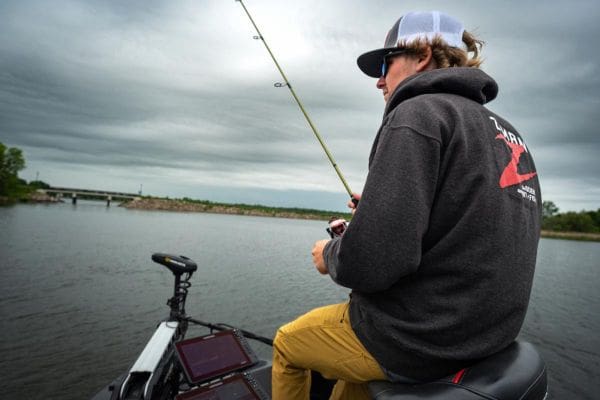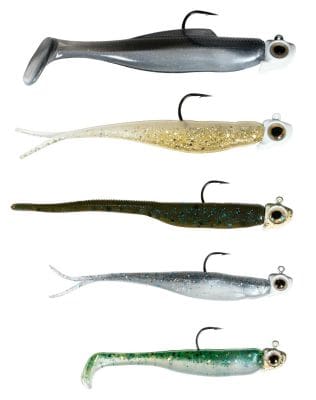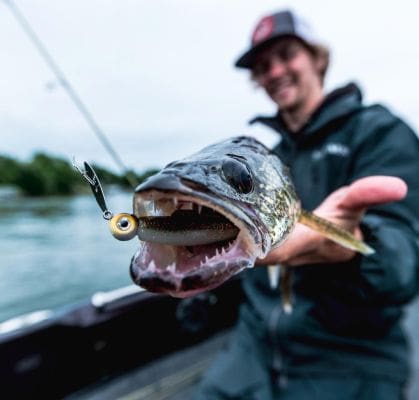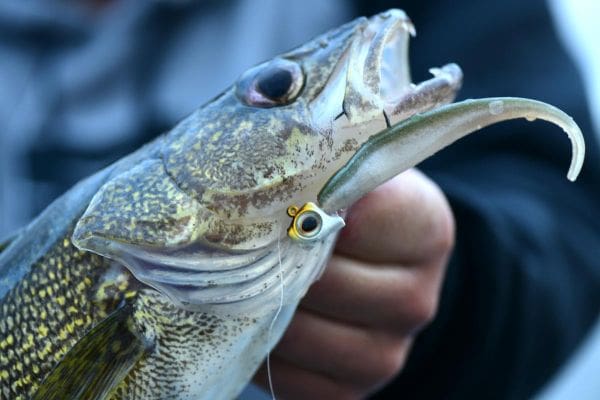Sonar Sight-Fishing Walleyes

Forward facing sonar Q&A with Z-Man® pro Dylan Nussbaum
A self-confessed “bass angler for walleyes,” young Z-Man walleye pro Dylan Nussbaum has helped popularize an exciting, interactive approach to his favorite species. “For me, it’s all about solving the mysteries of finding and catching walleyes,” contends the Pennsylvania based tournament champ. “Every day is a different challenge, and that, to me, is a lot of fun.”
Fresh off another tournament season on the National Walleye Tour—and another 35-thousand miles driving to the Dakotas, the Great Lakes and back home again—Nussbaum recently reflected on fishing strategy with forward facing sonar (FFS). Recognized for his talents at actively casting artificial lures and soft plastics from the bow of his boat, Nussbaum offers compelling perspectives on what has become the biggest trend in freshwater fishing today . . . sonar “sight fishing.”
Z-Man: When did you first start using forward facing sonar (FFS) for your walleye fishing?
Dylan: I got my first unit—a Lowrance Active Target—about two years ago. If I’m up casting from the front deck of my boat, I’m using FFS one hundred percent of the time. The more I use it, the more I learn about fish and their real-world response to my lure. It’s pretty addictive. (laughs).
Z-Man: Tell us about your on-water learning curve with FFS.
Dylan: For me, it didn’t take long—maybe two or three outings—before I started figuring things out relative to fish species ID and seeing my lure on screen. These units are pretty intuitive and easy to use, especially once you see what a walleye looks like on screen and then confirm its size once the fish is in the boat. A walleye or a bass tends to paint a pretty solid image. But a carp or a muskie, for example, can look a little grainy on the screen. Walleyes generally (though not always) move within a foot or two of bottom. They typically move and react to your lure just a little slower than a bass, for example.
Z-Man: What settings do you prefer for FFS fishing?
Dylan: If I’m out hunting fish on open flats, I’ll set the unit to scan out to 100 feet from the boat. Crank the sensitivity or gain (Lowrance calls it contrast) up to +10, especially for places like Lake Erie—or anywhere fish spook easily. If I’m around rock or stumps or vegetation, I’ll dial back to 4 or 5, and if I’m working smaller structures, I reduce range to about 60-feet. If I’m in giant boulders or trees or weeds, I might go with 40-feet—to zoom in and get a more accurate picture, especially to separate fish from objects or bottom.
I find that a good high contrast color palette, such as Lowrance’s number 6, a dark amber hue, really helps fish and your lure stick out on screen.
One other thing I started doing this year is running a dedicated battery just for powering my Active Target. A 12-volt 23-amp Dakota Lithium is connected directly to the unit, so I can run all day without draining other batteries.
Z-Man: What are some of the ideal scenarios you’ve discovered for targeting walleyes with FFS?
Dylan: This summer at Mille Lacs, Minnesota, I used it for hunting walleyes right along the edges of weedlines. By cruising along at ½- to 1-mph on the trolling motor, I could constantly scan and see little pods of fish stationed on specific areas. I’d stop, lock in place with the trolling motor and pitch a slip bobber and leech. Or a jig and Scented Jerk ShadZ™, especially for working a little faster. Believe I caught close to fifty walleyes one day fishing like this. Even in heavy vegetation, walleyes show up really nice.
Z-Man: Any other memorable recent outings with FFS?
Dylan: I discovered a super cool pattern on Lake Oahe this past year. Found scattered small pods of big walleyes suspended 15 feet down over 40 feet of water. I pitched a 3/8-ounce jig and Jerk ShadZ and watched fish shoot up ten to fifteen feet and just crush the lure.
What’s interesting is that I’ve found this same pattern happening on every lake I’ve been to since. You might see smaller walleyes near bottom, but the suspended fish are always bigger—like 5, 6 and 7 pounders.
Fished a similar scenario at the NWT Championship at Lake Erie this year. Cruising along at a half-mile-per-hour, I’d make wide sonar scans and eventually reveal these mega schools of 20 to 30 fish, all suspended 60 feet down over 80 feet of water. You’d get one or two casts on ‘em—and usually catch a fish on both casts—before the whole school would spook and vanish.
Z-Man: Where don’t you use FFS?
Dylan: I don’t use it in rivers very often—mostly because walleyes tend to hug super tight to bottom in current and they’re tougher to mark on screen. In rivers, I tend to read the water and current a lot more.

Z-Man: Any tips for finding your lure and keeping it on the screen?
Dylan: This does take some practice. Because the FFS beam is super narrow, you’ve got to get the lure right in front of the transducer’s line of sight. I’m usually rocking the trolling motor head left and right until I spot it. Lures with a nice flat, broad sided profile—like the Jerk ShadZ and 3-inch MinnowZ™ both shine back a nice strong signal. Solid metal lures such as a Jigging Rap also show up well. And the blade on Z-Man’s WillowVibe™ also reflects a nice signal as the blade flashes through the water.
On one hand, you want a lure that sinks fast to reach a fish before it vanishes. But a slower sinking bait that hovers a bit can be easier to follow on the screen. Usually, I’m more interested in watching fish react to the lure than watching the lure itself. So you might just see the lure’s initial descent before hitting bottom. But a fish’s reaction can tell you a lot about their interest level and what you want to do with your retrieve. At times, I find I can even tell when a walleye has eaten the lure just by watching its movements. Ideally, though, you want to watch the lure and the fish, as especially as the lure approaches within 40 or 50 feet of the boat, you can see the whole big picture . . .
About Z-Man Fishing Products: A dynamic Charleston, South Carolina based company, Z-Man Fishing Products has melded leading edge fishing tackle with technology for nearly three decades. Z-Man has long been among the industry’s largest suppliers of silicone skirt material used in jigs, spinnerbaits and other lures. Creator of the Original ChatterBait®, Z-Man is also the renowned innovators of 10X Tough ElaZtech softbaits, fast becoming the most coveted baits in fresh- and saltwater. Z-Man is one of the fastest-growing lure brands worldwide.


